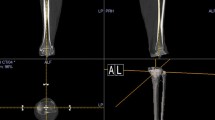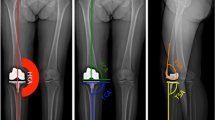Abstract
Background
Although many studies investigated the accuracy of customized cutting block (CCB), the data on rotational alignment are still lacking. The study aimed to assess whether CCB improved the component rotational position compared with conventional cutting instrument (CCI) using computed tomography scanning.
Methods
Eighty-six of 102 total knee arthroplasties from the previous randomized study were analyzed. The outcomes were rotational position of the femoral and tibial components, frequency of outliers and intra-class correlation coefficient.
Results
The mean femoral component rotation was not different between CCB versus CCI: 0.9° ± 0.8° versus 1.1° ± 1.1° (P = 0.29). Both groups had similar outlier frequencies: 2% (CCB) versus 2% (CCI) (P = 0.74). CCB had nearly 1° less mean tibial component deviation compared with CCI (P < 0.001): (1) dorsal tangent reference (DTR): 0.7° ± 0.8° versus 1.5° ± 1.0°, and (2) tibial trans-epicondylar reference (TTR): 0.5° ± 0.9° versus 1.4° ± 1.1°. Outlier frequencies were similar: (1) DTR: 0% CCB versus 5% CCI (P = 0.24), and (2) TTR: 5% in CCB versus 12% CCI (P = 0.20). Measurements based on tibial tubercle showed that CCB had ~ 1.4° less mean tibial component deviation compared with CCI: 0.3° ± 1.4° versus 1.7° ± 1.6° (P < 0.001) with a corresponding, less frequency of outliers: 0% versus 19% (P = 0.002). However, there was poor intra-observer reproducibility (0.61).
Conclusions
CCB did not improve femoral component rotational alignment compared with CCI nor affect outlier frequency, but it marginally improved the accuracy of tibial rotational alignment. The tibial tubercle reference point had poor intra-observer reproducibility.




Similar content being viewed by others
References
Sikorski JM (2008) Alignment in total knee replacement. J Bone Joint Surg Br 90(9):1121–1127. https://doi.org/10.1302/0301-620x.90b9.20793
Matsuda S, Kawahara S, Okazaki K, Tashiro Y, Iwamoto Y (2013) Postoperative alignment and ROM affect patient satisfaction after TKA. Clin Orthop Relat Res 471(1):127–133. https://doi.org/10.1007/s11999-012-2533-y
Ritter MA, Faris PM, Keating EM, Meding JB (1994) Postoperative alignment of total knee replacement. Its effect on survival. Clin Orthop Relat Res 299:153–156
Bargren JH, Blaha JD, Freeman MA (1983) Alignment in total knee arthroplasty. Correlated biomechanical and clinical observations. Clin Orthop Relat Res 173:178–183
Lotke PA, Ecker ML (1977) Influence of positioning of prosthesis in total knee replacement. J Bone Joint Surg Am 59(1):77–79
Akagi M, Matsusue Y, Mata T, Asada Y, Horiguchi M, Iida H, Nakamura T (1999) Effect of rotational alignment on patellar tracking in total knee arthroplasty. Clin Orthop Relat Res 366:155–163
Berger RA, Crossett LS, Jacobs JJ, Rubash HE (1998) Malrotation causing patellofemoral complications after total knee arthroplasty. Clin Orthop Relat Res 356:144–153
Huang NF, Dowsey MM, Ee E, Stoney JD, Babazadeh S, Choong PF (2012) Coronal alignment correlates with outcome after total knee arthroplasty: five-year follow-up of a randomized controlled trial. J Arthroplasty 27(9):1737–1741. https://doi.org/10.1016/j.arth.2012.03.058
Lombardi AV Jr, Berend KR, Adams JB (2008) Patient-specific approach in total knee arthroplasty. Orthopedics 31(9):927–930
Ast MP, Nam D, Haas SB (2012) Patient-specific instrumentation for total knee arthroplasty: a review. Orthop Clin N Am 43(5):e17–22. https://doi.org/10.1016/j.ocl.2012.07.004
Nam D, McArthur BA, Cross MB, Pearle AD, Mayman DJ, Haas SB (2012) Patient-specific instrumentation in total knee arthroplasty: a review. J Knee Surg 25(3):213–219
Cavaignac E, Pailhe R, Laumond G, Murgier J, Reina N, Laffosse JM, Berard E, Chiron P (2015) Evaluation of the accuracy of patient-specific cutting blocks for total knee arthroplasty: a meta-analysis. Int Orthop 39(8):1541–1552. https://doi.org/10.1007/s00264-014-2549-x
Thienpont E, Schwab PE, Fennema P (2014) A systematic review and meta-analysis of patient-specific instrumentation for improving alignment of the components in total knee replacement. Bone Joint J 96-b(8):1052–1061. https://doi.org/10.1302/0301-620x.96b8.33747
Fu H, Wang J, Zhou S, Cheng T, Zhang W, Wang Q, Zhang X (2015) No difference in mechanical alignment and femoral component placement between patient-specific instrumentation and conventional instrumentation in TKA. Knee Surg Sports Traumatol Arthrosc 23(11):3288–3295. https://doi.org/10.1007/s00167-014-3115-1
Voleti PB, Hamula MJ, Baldwin KD, Lee GC (2014) Current data do not support routine use of patient-specific instrumentation in total knee arthroplasty. J Arthroplasty 29(9):1709–1712. https://doi.org/10.1016/j.arth.2014.01.039
Russell R, Brown T, Huo M, Jones R (2014) Patient-specific instrumentation does not improve alignment in total knee arthroplasty. J Knee Surg 27(6):501–504. https://doi.org/10.1055/s-0034-1368143
Mannan A, Smith TO, Sagar C, London NJ, Molitor PJ (2015) No demonstrable benefit for coronal alignment outcomes in PSI knee arthroplasty: a systematic review and meta-analysis. Orthop Traumatol Surg Res 101(4):461–468. https://doi.org/10.1016/j.otsr.2014.12.018
Noble JW Jr, Moore CA, Liu N (2012) The value of patient-matched instrumentation in total knee arthroplasty. J Arthroplasty 27(1):153–155. https://doi.org/10.1016/j.arth.2011.07.006
Daniilidis K, Tibesku CO (2013) Frontal plane alignment after total knee arthroplasty using patient-specific instruments. Int Orthop 37(1):45–50. https://doi.org/10.1007/s00264-012-1732-1
Daniilidis K, Tibesku CO (2014) A comparison of conventional and patient-specific instruments in total knee arthroplasty. Int Orthop 38(3):503–508. https://doi.org/10.1007/s00264-013-2028-9
Vundelinckx BJ, Bruckers L, De Mulder K, De Schepper J, Van Esbroeck G (2013) Functional and radiographic short-term outcome evaluation of the Visionaire system, a patient-matched instrumentation system for total knee arthroplasty. J Arthroplasty 28(6):964–970. https://doi.org/10.1016/j.arth.2012.09.010
Heyse TJ, Tibesku CO (2014) Improved femoral component rotation in TKA using patient-specific instrumentation. Knee 21(1):268–271. https://doi.org/10.1016/j.knee.2012.10.009
Tammachote N, Panichkul P, Kanitnate S (2017) Comparison of customized cutting block and conventional cutting instrument in total knee arthroplasty: a randomized controlled trial. J Arthroplasty 15:12. https://doi.org/10.1016/j.arth.2017.09.055
Berger RA, Rubash HE, Seel MJ, Thompson WH, Crossett LS (1993) Determining the rotational alignment of the femoral component in total knee arthroplasty using the epicondylar axis. Clin Orthop Relat Res 286:40–47
Barrack RL, Schrader T, Bertot AJ, Wolfe MW, Myers L (2001) Component rotation and anterior knee pain after total knee arthroplasty. Clin Orthop Relat Res 392:46–55
Heyse TJ, Stiehl JB, Tibesku CO (2015) Measuring tibial component rotation of TKA in MRI: what is reproducible? Knee 22(6):604–608. https://doi.org/10.1016/j.knee.2015.01.009
Bonnin MP, Saffarini M, Mercier PE, Laurent JR, Carrillon Y (2011) Is the anterior tibial tuberosity a reliable rotational landmark for the tibial component in total knee arthroplasty? J Arthroplasty 26(2):260–267. https://doi.org/10.1016/j.arth.2010.03.015
Luring C, Perlick L, Bathis H, Tingart M, Grifka J (2007) The effect of femoral component rotation on patellar tracking in total knee arthroplasty. Orthopedics 30(11):965–967
Keshmiri A, Maderbacher G, Baier C, Zeman F, Grifka J, Springorum HR (2016) Significant influence of rotational limb alignment parameters on patellar kinematics: an in vitro study. Knee Surg Sports Traumatol Arthrosc 24(8):2407–2414. https://doi.org/10.1007/s00167-014-3434-2
Rhoads DD, Noble PC, Reuben JD, Mahoney OM, Tullos HS (1990) The effect of femoral component position on patellar tracking after total knee arthroplasty. Clin Orthop Relat Res 260:43–51
Incavo SJ, Wild JJ, Coughlin KM, Beynnon BD (2007) Early revision for component malrotation in total knee arthroplasty. Clin Orthop Relat Res 458:131–136. https://doi.org/10.1097/BLO.0b013e3180332d97
Pietsch M, Hofmann S (2012) Early revision for isolated internal malrotation of the femoral component in total knee arthroplasty. Knee Surg Sports Traumatol Arthrosc 20(6):1057–1063. https://doi.org/10.1007/s00167-011-1637-3
Bedard M, Vince KG, Redfern J, Collen SR (2011) Internal rotation of the tibial component is frequent in stiff total knee arthroplasty. Clin Orthop Relat Res 469(8):2346–2355. https://doi.org/10.1007/s11999-011-1889-8
Parratte S, Blanc G, Boussemart T, Ollivier M, Le Corroller T, Argenson JN (2013) Rotation in total knee arthroplasty: no difference between patient-specific and conventional instrumentation. Knee Surg Sports Traumatol Arthrosc 21(10):2213–2219. https://doi.org/10.1007/s00167-013-2623-8
Victor J, Dujardin J, Vandenneucker H, Arnout N, Bellemans J (2014) Patient-specific guides do not improve accuracy in total knee arthroplasty: a prospective randomized controlled trial. Clin Orthop Relat Res 472(1):263–271. https://doi.org/10.1007/s11999-013-2997-4
Chotanaphuti T, Wangwittayakul V, Khuangsirikul S, Foojareonyos T (2014) The accuracy of component alignment in custom cutting blocks compared with conventional total knee arthroplasty instrumentation: prospective control trial. Knee 21(1):185–188. https://doi.org/10.1016/j.knee.2013.08.003
Heyse TJ, Tibesku CO (2015) Improved tibial component rotation in TKA using patient-specific instrumentation. Arch Orthop Trauma Surg 135(5):697–701. https://doi.org/10.1007/s00402-015-2157-2
Acknowledgements
Our institution provided the funding for this study. We thank Dr. Bob Taylor for reviewing the linguistic content of the article. We also thank all participants for providing the data used in this study.
Funding
This study was funded by Thammasat University.
Author information
Authors and Affiliations
Corresponding author
Ethics declarations
Conflict of interest
Nuttawut Chanalithichai, Nattapol Tammachote, Chane Jitapunkul and Supakit Kanitnate declared that they have no conflicts of interest. All authors have completed and submitted the ICMJE Form for Disclosure of Potential Conflicts of Interest.
Additional information
Publisher's Note
Springer Nature remains neutral with regard to jurisdictional claims in published maps and institutional affiliations.
Investigation performed at Thammasat University Hospital, Faculty of Medicine, Thammasat University, Pathumthani, Thailand.
Rights and permissions
About this article
Cite this article
Chanalithichai, N., Tammachote, N., Jitapunkul, C. et al. Rotational component alignment in patient-specific total knee arthroplasty compared with conventional cutting instrument. Eur J Orthop Surg Traumatol 29, 1297–1304 (2019). https://doi.org/10.1007/s00590-019-02423-5
Received:
Accepted:
Published:
Issue Date:
DOI: https://doi.org/10.1007/s00590-019-02423-5




